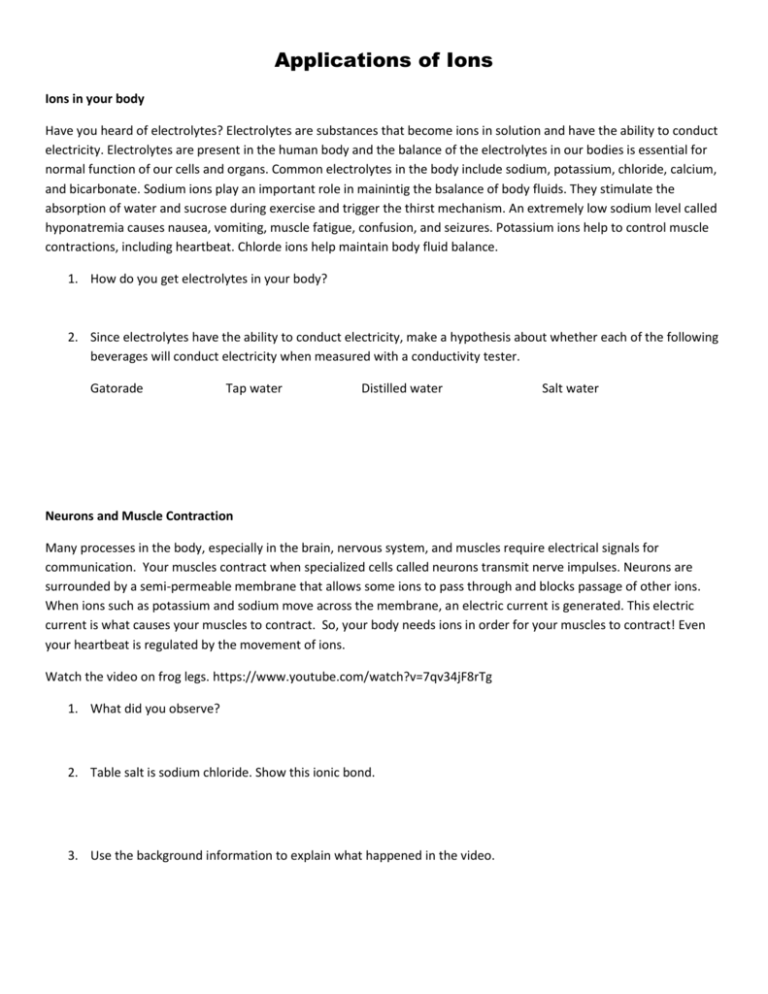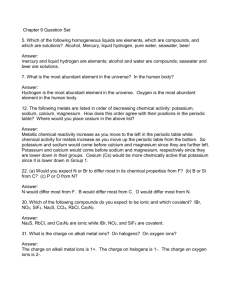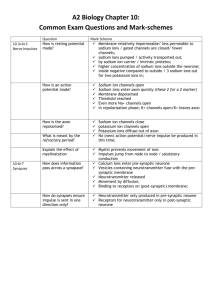Applications of Ions - Physical Science Chemistry
advertisement

Applications of Ions Ions in your body Have you heard of electrolytes? Electrolytes are substances that become ions in solution and have the ability to conduct electricity. Electrolytes are present in the human body and the balance of the electrolytes in our bodies is essential for normal function of our cells and organs. Common electrolytes in the body include sodium, potassium, chloride, calcium, and bicarbonate. Sodium ions play an important role in mainintig the bsalance of body fluids. They stimulate the absorption of water and sucrose during exercise and trigger the thirst mechanism. An extremely low sodium level called hyponatremia causes nausea, vomiting, muscle fatigue, confusion, and seizures. Potassium ions help to control muscle contractions, including heartbeat. Chlorde ions help maintain body fluid balance. 1. How do you get electrolytes in your body? 2. Since electrolytes have the ability to conduct electricity, make a hypothesis about whether each of the following beverages will conduct electricity when measured with a conductivity tester. Gatorade Tap water Distilled water Salt water Neurons and Muscle Contraction Many processes in the body, especially in the brain, nervous system, and muscles require electrical signals for communication. Your muscles contract when specialized cells called neurons transmit nerve impulses. Neurons are surrounded by a semi-permeable membrane that allows some ions to pass through and blocks passage of other ions. When ions such as potassium and sodium move across the membrane, an electric current is generated. This electric current is what causes your muscles to contract. So, your body needs ions in order for your muscles to contract! Even your heartbeat is regulated by the movement of ions. Watch the video on frog legs. https://www.youtube.com/watch?v=7qv34jF8rTg 1. What did you observe? 2. Table salt is sodium chloride. Show this ionic bond. 3. Use the background information to explain what happened in the video. https://www.youtube.com/watch?v=K0sMSvH4T7g (start at 55 seconds) Tasers https://www.youtube.com/watch?v=_sN4bvQrBBY Slow motion: https://www.youtube.com/watch?v=576HwhU6PMM The Taser is widely used by police because it allows officers to capture suspects by immobilizing them. A person who is receiving a Taser is still conscious of his or her surroundings, but cannot move a muscle. A Taser fires two metal pointed dart-like electrodes that are designed to go through clothing and skin. The electrodes are attached to metal wires, some as long as 35 feet. The electrodes are propelled at a speed of over 120 miles per hour. The electrodes deliver a high voltage shock to the person being Tasered. Electricity is simply a flow of electrons in a conductor. In the body, the Taser interferes with the natural functioning of nerve cells, causing all the muscles to contract, making it impossible for the victim to move. Muscles contract in response to “instructions” from neurons. The electrical pulse from a Taser overwhelms the natural process by increasing the rate at which nerve signals are transmitted through neurons, resulting in the loss of muscle control. 1. Knowing what your body is mostly made of, why is it possible for an electric current from a Taser to flow through the body? Plants absorb energy from sunlight through the process of Photosynthesis. Sunlight is 'trapped' by chlorophyll, providing energy to convert carbon dioxide and water into glucose and oxygen. A magnesium ion is at the of each chlorophyll molecule. Plants also need nutrients for healthy growth. Inorganic ions are obtained from the soil where they are dissolved in water. The three ions required in the greatest amounts are nitrate, phosphate and potassium - sources of nitrogen (N), phosphorus (P) and potassium (K) respectively. Smaller amounts of magnesium (Mg 2+), calcium (Ca2+) and some other ions are also required. https://www.youtube.com/watch?v=Ral9wog5-D0











